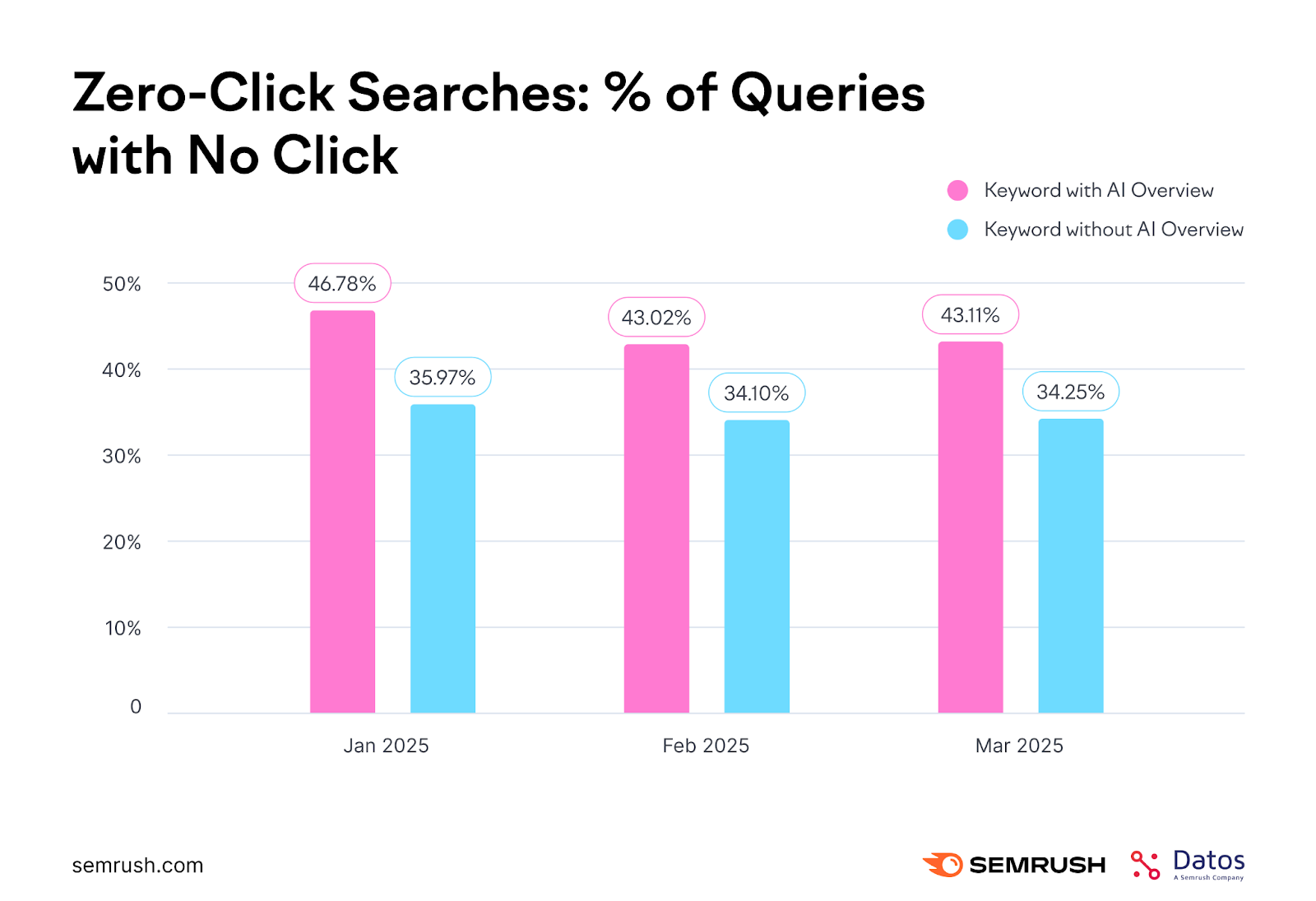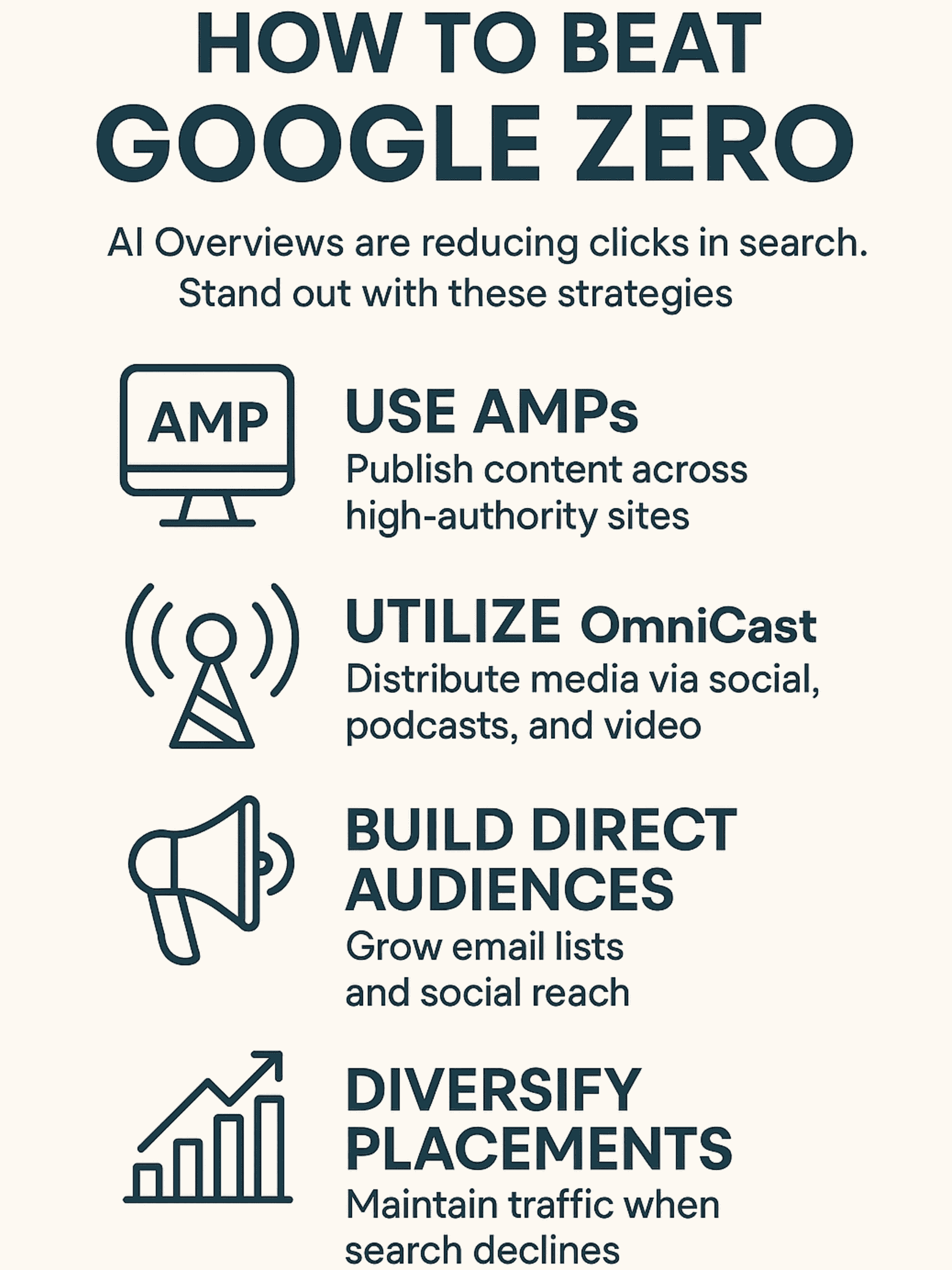Main Points
- Google Zero is a new feature that uses AI to provide direct answers to search queries, which has led to a decrease in website traffic by up to 69% for some businesses
- As Google evolves from a search engine into an answer engine, traditional SEO strategies are becoming less effective
- LeafWorldMedia’s Amplified Media Placements (AMPs) can help businesses increase their visibility on over 300 high-authority sites that are trusted by AI systems
- OmniCast’s multi-channel distribution allows businesses to reach audiences beyond Google, protecting them from the volatility of search algorithms
- Businesses that start implementing authority-building strategies now will have a significant competitive advantage as others struggle with decreasing search visibility
The way we search for information is changing more than it has since Google was first created. If you’ve noticed a decrease in your website traffic even though you’re still ranking well, you’re experiencing the effects of Google Zero firsthand.
LeafWorldMedia has been working on solutions to this exact problem, helping businesses to succeed even as traditional search visibility decreases. Through strategic Amplified Media Placements and OmniCast distribution, businesses are finding new ways to reach their audiences without relying solely on organic search.
The Game Changer: Google Zero and What It Means for You
Google Zero is not a term coined by Google, but rather by digital marketers. It refers to the new norm where websites are getting zero clicks from Google search results. This is happening because Google’s AI now provides direct answers to user queries at the top of search results, making it unnecessary for users to visit websites. This has significant and widespread implications for businesses that rely on search traffic.
The Surprising Reality of Traffic Decrease From AI-Driven Search
The statistics reveal a worrying narrative. Ever since Google introduced AI Overviews in May 2024, zero-click searches have risen from 56% to an alarming 69%. This implies that for over two-thirds of searches, users do not click through to any website. For companies that have been optimizing for organic traffic for years, this suggests a potential loss of millions in revenue as fewer potential customers reach their online doorstep.
Industries that are most impacted include information content providers, instructional websites, and businesses with offerings that can be easily summarized. When Google can pull and present your main value proposition directly in search results, why would users need to visit your site at all?
Why Your Previous SEO Tactics Are Now Obsolete
The old SEO methods that prioritized keywords, backlinks, and on-page optimization are quickly becoming outdated. In this new age of Google Zero, even if you manage to get a #1 ranking, it doesn’t mean you’ll get the traffic you’re expecting. AI Overviews are now the main focus, taking precedence over all organic results.
- There is no longer a direct correlation between rankings and traffic or business results
- Content that is only optimized for search engines is summarized and displayed without attribution
- As Google prioritizes delivering answers over sending visitors, the returns from technical SEO improvements are diminishing
- When AI understands intent beyond specific search terms, keyword research becomes less valuable
- When authority becomes more about brand recognition than link quantity, backlink strategies struggle
The main shift is this: Google is evolving from a search engine that connects users to information sources to an answer engine that provides information directly. This transformation requires a completely new approach to digital visibility.
Seeing the Silver Lining in this Digital Upheaval
Many perceive Google Zero as a menace, but innovative marketers see it as a golden chance to stand out. As rivals stick to obsolete SEO strategies, businesses that are quick to adjust can seize a large portion of the market and form more robust direct connections with their audiences.
There’s a chance to go beyond the confines of Google. When your brand is visible on a variety of reputable platforms, you create points of contact that are not dependent on search algorithms. LeafWorldMedia’s strategy is centred on this—building visibility that is respected by AI systems and creating channels that connect directly with your audience.
Companies that are successful in the age of Google Zero know that the key to digital dominance isn’t about tricking algorithms—it’s about becoming the go-to source that even AI systems can’t ignore. This creates a strong positive cycle: more authority leads to more AI features, which in turn leads to even more authority. For businesses looking to enhance their online presence, being featured on Google News can significantly boost authority and visibility.

5 Effective Strategies to Conquer Google Zero and Excel in AI Search
Google Zero’s solution isn’t to give up on search—it’s to change your approach to fit the new reality. The most successful businesses are implementing multi-pronged strategies that cooperate with AI systems rather than oppose them. Here are five proven strategies that LeafWorldMedia has implemented with clients who are seeing exceptional results despite the changing search landscape.
1. Craft Content That Attracts AI and Lands in Overviews
Google’s AI Overviews are generated from sources that Google trusts. By crafting content that is designed to be featured in these overviews, your brand can still gain visibility even if there are no direct clicks. This involves creating content that is structured with factual and clear statements that directly answer the questions users are asking and positioning your brand as the go-to source on your topic.
At LeafWorldMedia, we believe in creating “citation-worthy content” that’s so authoritative, AI systems have no choice but to reference it when providing answers to related queries. This means we go beyond just providing basic information. We offer unique data, expert insights, and comprehensive analysis that you can’t find anywhere else.
2. Create a Diverse Digital Presence
Expanding your digital presence beyond just Google search is not just a nice-to-have anymore—it’s a must-have. By creating a diverse digital presence, you can ensure your message gets to your audience no matter what changes happen with search algorithms. This means being strategic about your presence on social media, video networks, podcasts, email lists, and media partnerships.
Businesses that are most successful in weathering changes in Google traffic have strong audience connections on at least five different channels. These alternative routes ensure that visibility and lead flow remain consistent, even when Google traffic fluctuates. LeafWorldMedia’s OmniCast system is designed to meet this need, delivering your message across multiple platforms at the same time.
3. Use Authority Indicators That AI Systems Rely On
AI systems such as those that drive Google’s search functions depend greatly on identifiable authority indicators when deciding what information to highlight. These indicators include regular brand mentions on authoritative sites, expert bylines, verifiable credentials, and official partnerships. By strategically boosting these indicators, you place your brand as the go-to source that AI cannot ignore.
The main point to remember is that authority is cumulative and interconnected. When your brand is mentioned in a variety of high-quality contexts, AI systems recognize patterns that indicate trustworthiness. This is why LeafWorldMedia’s approach is to build a coordinated network of mentions instead of isolated placements.
4. Make the Most of Voice and Conversational Search
As AI interfaces become more chat-like, it’s becoming more important to optimize for natural language patterns. Voice search and chat-based interfaces are growing areas of search activity, each with unique traits that savvy marketers can take advantage of. Content that’s structured around questions, conversational phrases, and contextual information does particularly well in these settings.
The companies that are doing the best in voice and conversational search have created a detailed question-and-answer framework that addresses user questions in a natural, helpful way. This strategy matches up perfectly with how AI systems process and prioritize information for users who want fast, accurate answers.
5. Concentrate on Unique Value that AI Can’t Summarize
The most effective strategy against Google Zero might be to create content and experiences that AI can’t summarize. This could include interactive tools, community experiences, exclusive data visualizations, and personalized content that requires direct engagement. When the main value can’t be extracted and displayed in a search result, users will have a compelling reason to visit your owned properties.
LeafWorldMedia assists companies in recognizing and cultivating these “AI-proof” assets that retain their worth no matter how search technology advances. In a world where AI systems increasingly commoditize generic information, these become enduring competitive edges.

LeafWorldMedia’s AMPs: Your Secret Weapon for Digital Visibility
Our strategy for beating Google Zero revolves around our unique Amplified Media Placements (AMPs). This proprietary system doesn’t just spread your brand across hundreds of authoritative platforms—it does so in a coordinated way that’s specifically designed to outsmart modern AI systems. Unlike traditional PR or content syndication, our AMPs create a visibility network that’s perfectly calibrated to the way AI evaluates and prioritizes information sources.
Understanding Amplified Media Placements
Amplified Media Placements, or AMPs, are pieces of content that are carefully created and shared across LeafWorldMedia’s network. This network includes premium publishers, news sites, industry portals, and influential platforms. Each placement is optimized to both engage humans and be recognized by AI. This creates strong authority signals that improve your brand’s digital presence. AMPs are not random backlinks or occasional guest posts. They are a coordinated system where each placement strengthens the others. This creates visibility growth that is exponential, not linear.
Over 300 High-Authority Sites That Increase Your Credibility
LeafWorldMedia’s network is made up of more than 300 meticulously chosen publishing partners. These partners include news sites, industry journals, and specialized publications. They’re not just any blogs or low-quality directories. They are established platforms that are already considered authoritative by Google’s AI. When your content is distributed across this network, it creates a robust web of credibility signals that not even the most advanced AI can overlook.
These placements range from business publications and technology platforms to industry-specific outlets and general interest media. This is important because it tells AI systems that your brand is relevant and authoritative across a wide range of topics, not just in one specific area.
How AMPs Send Unavoidable Signals to Google’s AI
The power of AMPs is their capacity to generate what we refer to as “recognition density”. This is a significant amount of mentions and citations that make AI systems recognize your brand as an authority. When Google’s algorithms see your brand being mentioned across many trusted sources in a short time, it sets off recognition patterns that increase your visibility in AI-generated answers. For businesses looking to enhance their digital marketing strategies, effective use of Facebook and Google Ads can complement AMPs to boost recognition.
Unlike traditional link building or PR, this method is tailored to how modern AI assesses information sources. The coordinated nature of these placements forms patterns that machine learning systems are trained to identify as signs of legitimacy and authority.
OmniCast: The Key to Increasing Your Search Traffic
AMPs may help establish your credibility within Google’s ecosystem, but OmniCast allows you to reach a much broader audience. This unique distribution system guarantees that your message will reach your audience no matter what their preferred method of consuming content is, creating numerous routes to your business that aren’t reliant on Google search.
Reaching Your Audience Beyond Google: Wherever They May Be
OmniCast allows you to synchronize your content across multiple platforms such as social media, video networks, podcast directories, email newsletters, and community forums all at once. This method provides multiple opportunities for connecting with your audience that don’t rely on search algorithms. By consistently presenting your message across various channels, you reinforce brand recognition and create multiple pathways to conversion.
Even if a single channel goes down, the system is designed to keep you in the spotlight. This kind of resilience is becoming more important as platform algorithms become more volatile and unpredictable. When Google traffic goes down, these alternative channels keep the audience engagement consistent.
The Power of Multi-Format: Text, Video, Audio, and Social
OmniCast has the ability to mold your central message to fit the distinct needs of various media formats. One campaign can produce text articles, short videos, podcast episodes, and social media content—each one is optimized for its specific platform while keeping a consistent message. This multi-format method makes sure your content is seen wherever your audience chooses to get their information.
Various audience groups usually prefer various content formats. By keeping a presence in text, video, audio, and social at the same time, you can get the attention of prospects who might miss your message if it was only in one format. This full coverage creates many chances for discovery and engagement.
Building Direct Audience Relationships with OmniCast
One of the most significant benefits of using OmniCast is that it can help turn your passive audience into a group of individuals you have a direct relationship with. Each distribution point offers strategic pathways to a direct connection, such as email signups, community memberships, app downloads, and other conversion opportunities. This allows you to establish direct communication channels with your audience.
As intermediary platforms such as Google continue to put more obstacles between businesses and their audiences, the value of these owned audience relationships increases. Being able to reach your prospects directly means you’re no longer reliant on search visibility for business success. To explore more on this topic, consider checking out our guide on measuring the ROI of multi-platform content distribution.

Actual Outcomes: Companies Flourishing in Spite of Google Zero
Case Study: How a Local Business Grew 215% After Traffic Dropped
When regional healthcare provider MedWell experienced a sudden 42% drop in search traffic following Google’s AI Overview launch, they initially panicked. Their traditional SEO agency offered no solutions beyond “wait and see what happens.” After implementing LeafWorldMedia’s comprehensive strategy, including targeted AMPs across healthcare publications and local news outlets, they not only recovered but grew total patient inquiries by 215% within six months.
What made them successful wasn’t resisting the shift to AI, but rather taking advantage of it. They established their physicians as experts quoted across various authoritative sources, and thus became the references from which Google’s AI drew information. In addition, their OmniCast campaign created a strong presence on platforms where their target audience often visited, including Facebook groups for parents and community forums for seniors.
The E-Commerce Brand That Doubled Conversions Through AMPs
GreenLife Essentials, an online retailer, was finding it hard to keep their sustainable household products visible as Google started featuring their larger competitors more often in AI Overviews. However, after they started a strategic AMP campaign that highlighted their unique environmental certifications across relevant publication networks, they saw that their products were mentioned in 73% of sustainability-related AI Overviews within their category. This increased their brand recognition, which led to a 127% increase in direct site visits and doubled their conversion rate, even though their search traffic stayed the same.
The success of the campaign can be attributed to the strategic placement of GreenLife’s unique environmental credentials in contexts where AI systems would see them as authoritative information. Instead of vying for traditional keywords, they became the go-to source for specific sustainability metrics that Google’s AI needed to include in its overviews.
A 30-Day Game Plan to Triumph Over Google Zero
Week 1: Evaluate Your Current Online Presence
Start by thoroughly examining your current digital presence across search engines, social media, and industry publications. Identify which search terms are triggering AI Summaries in your industry and determine whether your brand is being highlighted or omitted. Record traffic trends before and after significant Google AI updates to set baseline measurements and identify at-risk traffic sources. This evaluation will expose both immediate risks and opportunities specific to your business. For more insights, consider how your business can be featured on Google News.
Week 2: Launch Your First AMP Campaign
Using the results from your audit, create your first Amplified Media Placement strategy that targets the areas with the highest potential impact. Collaborate with LeafWorldMedia to determine the best blend of publication types for your industry and audience. Develop key content pieces that highlight your unique skills and value propositions in formats that are designed for the best AI visibility.
Start by concentrating on creating strong authority signals around your main business services. These initial placements will form the basis of the recognition patterns that future campaigns will expand on. Keep in mind that the first AMP campaigns are all about creating a presence across several authority sources at the same time.
Keep an eye on how your content is doing across the network in real time, not just in terms of where it’s being published but also how audiences are interacting with it. Use this information to tweak your content strategy and get the best results. The aim is to make a big splash all at once, which will get the attention of AI systems.
Align your owned media channels with the AMP campaign, so your website, social profiles, and direct marketing all echo the same core messages. This alignment fortifies recognition patterns across platforms and establishes consistent authority signals.
Here is the human content:
- Identify 3-5 main topics that align with your business goals
- Create compelling content that meets publisher requirements
- Target your first placements across 25-50 strategic publications
- Set up a measurement framework to track visibility and engagement
- Create additional social and owned media content to boost placements
Week 3: Launch Your OmniCast Strategy
Once you’ve established your authority through AMPs, increase your visibility with OmniCast’s multi-channel distribution system. Adapt your main content themes into versions that are specific to each format, optimized for video platforms, podcast networks, social channels, and community forums. The focus here is to translate your message into the native formats for each platform, while keeping your positioning consistent.
Set up ways to grab your audience’s attention on all your distribution points. This will create a clear path to building direct relationships. You can do this through email signups, community memberships, app downloads, or other conversion opportunities. This will help you establish communication channels that don’t rely on search and social algorithms.
Week 4: Assessing Outcomes and Expanding Successful Tactics
Perform a thorough review of performance across all platforms, pinpointing which placements, formats, and messages elicited the most powerful audience reactions. Expand your assessment beyond conventional metrics like traffic to include growth in direct audience relationships, brand mentions, and presence in AI-generated content. These indicators are often a more accurate predictor of future business impact than immediate traffic metrics.
From your analysis, you should come up with a more comprehensive strategy that focuses more on your best performing methods. This could mean focusing on certain categories of publications, formats of content, or themes of messages that showed exceptional traction. The aim is to transition from initial testing to a sustainable visibility system that continuously strengthens your authority position.
What’s happening in search isn’t just another algorithm update—it’s a complete overhaul of how people seek out information online. Businesses that spot this trend early and put together thorough strategies will be light years ahead of competitors who keep optimizing for a search paradigm that’s quickly going extinct. For businesses looking to stay ahead, understanding the buyer journey map can be a crucial part of developing effective strategies.
Brands that have embraced AMPs and OmniCast strategies are already reaping the rewards. While their competitors flounder as traffic drops, these brands are creating powerful visibility networks that go beyond the Google ecosystem. The gap between these two strategies will only grow as AI becomes more integrated into search.
Top performing companies know that the key isn’t to battle AI, but to cooperate with its underlying mechanisms. By developing the authority indicators that AI systems recognize and appreciate, you establish your brand as a critical reference that needs to be included, rather than a replaceable resource that can be summarized and overlooked.
LeafWorldMedia has been ahead of the curve, preparing for this change before it even started. We have built systems specifically designed to help businesses flourish in the AI-driven information landscape. We do this by building visibility that AI respects and direct audience relationships that algorithms can’t disintermediate. The future of digital marketing isn’t about ranking—it’s about recognition.
Common Queries
While companies are trying to adapt to the Google Zero change, they often have questions about how to go about it, the timeline, and what they should focus on. Here are the answers to the most frequently asked questions we get from clients who are implementing AMPs and OmniCast campaigns.
How soon can I expect results from LeafWorldMedia’s AMPs?
Most companies notice a significant improvement within the first 30 days of launching their initial AMP campaign. The initial results usually include an increase in brand mentions on reputable websites, a better presence in AI Overviews, and an increase in direct traffic to the site. The full effect is usually seen between 90-120 days as the authority signals build up and the reinforcement patterns across the network become stronger.
Should I create separate content for AMPs and OmniCast?
Not at all, your main message should be the same on all platforms. The content team at LeafWorldMedia will take your base content and modify it to meet the specific needs of each platform. This will keep your positioning consistent while also increasing engagement across different types of media. You bring the knowledge and main message, and we’ll take care of adjusting and optimizing it for each channel we distribute it on.
What’s the real effect of Google Zero on my site’s traffic?
It really depends on your industry and the type of content you’re offering. If your business provides information that’s easy to summarize (like basic how-to content, simple facts, or standard definitions), you’re likely to see the biggest drop in traffic—sometimes as much as 40-70%. But if your company offers complex products, specialized expertise, or unique methods, your traffic might not take as big a hit. That said, it’s still a good idea to come up with a strategy to deal with Google Zero. When we first start working with you, we’ll figure out how much of a risk Google Zero poses to you and identify the traffic sources that are most at risk.
Is it possible for small businesses to hold their own against bigger brands in the Google Zero era?
Definitely—and in fact, smaller businesses may have an edge in this new environment. Bigger companies often grapple with bureaucratic approval processes and disjointed messaging, but smaller businesses can put coordinated visibility strategies in place rapidly and keep their messaging consistent across all channels. The secrets to winning are specificity and commitment: concentrating on well-defined areas of authority and adopting comprehensive strategies rather than patchwork ones.
Small businesses that concentrate on creating name recognition within certain niches frequently perform better than larger competitors who dilute their efforts across a wide range of topics. LeafWorldMedia’s platforms are tailored to assist businesses of all sizes in creating the authority signals necessary to succeed in the era of AI search.
Which metrics should I follow to gauge success against Google Zero?
Standard SEO metrics such as rankings and search traffic lose their relevance in the Google Zero environment. More significant indicators include: presence in AI-generated content (how frequently your brand is included in AI Overviews), authority mention frequency (how often you are cited across high-value publications), direct traffic growth (visitors coming straight to your website), and owned audience expansion (growth in email subscribers, community members, app users, and other direct relationships).
LeafWorldMedia’s reporting systems automatically track these next-generation metrics, giving you a clear view of your increasing digital authority. We particularly focus on the links between AMP campaigns and subsequent improvements in brand presence within AI-generated content, as this link often most accurately predicts future business growth.
Instead of just focusing on traffic, the most critical change in metrics is to measure various avenues to business expansion. By including both AI authority and direct audience relationships in your visibility strategy, your business can withstand changes in algorithms and disruptions in platforms.
Are you prepared to secure your online presence against Google Zero? LeafWorldMedia’s holistic approach to AMPs and OmniCast distribution allows businesses of all sizes to establish a reputation that not even AI can overlook.







Leave a Reply